
Australian art is a broad spectrum of art created in or about Australia, or by Australians overseas, spanning from prehistoric times to the present day. The art forms include, but are not limited to, Aboriginal, Colonial, Landscape, Atelier, and Contemporary art.
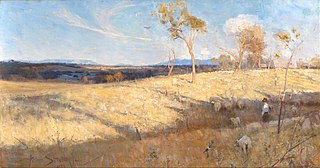
The Heidelberg School was an Australian art movement of the late 19th century. It has been described as Australian impressionism.
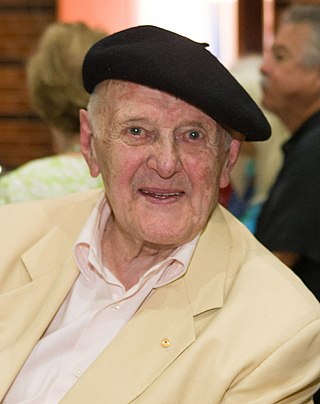
John Henry Olsen AO OBE was an Australian artist and winner of the 2005 Archibald Prize. Olsen's primary subject of work was landscape.
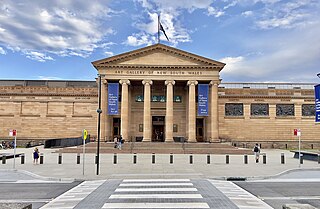
The Art Gallery of New South Wales (AGNSW), founded as the New South Wales Academy of Art in 1872 and known as the National Art Gallery of New South Wales between 1883 and 1958, is located in The Domain, Sydney, Australia. It is the most important public gallery in Sydney and one of the largest in Australia.
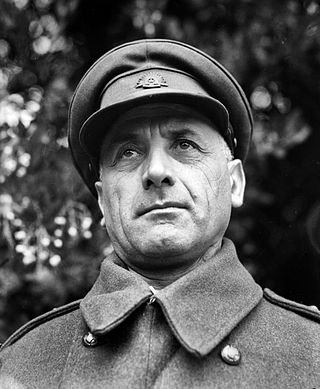
Sali Herman was a Swiss-born Australian artist, one of Australia's Official War Artists for the Second World War.
Janet Dawson MBE is an Australian artist who was a pioneer of abstract painting in Australia in the 1960s, having been introduced to abstraction during studies in England while she lived in Europe 1957–1960 She was also an accomplished lithographic printer of her own works as well as those of other renowned Australian artists, a theatre-set and furniture designer. She studied in England and Italy on scholarships before returning to Australia in 1960. She won the Art Gallery of New South Wales Archibald Prize in 1973 with the portrait of her husband, Michael Boddy Reading. She has exhibited across Australia and overseas, and her work is held in major Australian and English collections. In 1977 she was awarded an MBE for services to art.
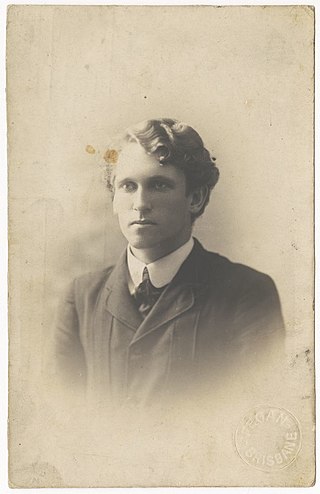
Lloyd Frederic Rees was an Australian landscape painter who twice won the Wynne Prize for his landscape paintings.

Elioth Lauritz Leganyer Gruner was an Australian artist. A successor of the plein air Heidelberg School tradition in Australian art, Gruner is known for his high-key impressionist landscapes and his ability to capture the ephemeral effects of light. According to Norman Lindsay, Gruner "painted the purest light that ever has been seen on a bit of canvas".
George Feather Lawrence (1901–1981) was born in Sydney, Australia and for many years was regarded as one of the foremost painters in the impressionist style. He studied under Julian Rossi Ashton at the famous Sydney Art School in the old Queen Victoria Building; and later in London and Paris.
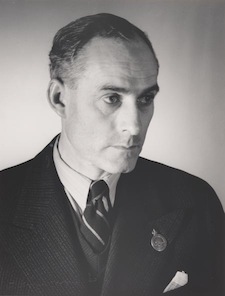
Adrian George Feint was an Australian artist. He worked in various media, and is noted for his bookplate designs.

Tim Storrier AM is an Australian artist who won the 2012 Doug Moran National Portrait Prize with The Lunar Savant, a portrait of fellow artist McLean Edwards.
Harold Frederick Weaver Hawkins (1893–1977) was an English painter and printmaker working with the techniques of etching, monotypes, linocuts and woodcuts. He specialized in "ambitious, sometimes mural-sized, modernist allegories of morality for an age of atomic warfare and global over-population." He was active from 1923 to 1972.

Spring Frost is a 1919 painting by the Australian artist Elioth Gruner. The painting depicts a small herd of dairy cows in the early morning. Gruner's most well-known painting, Spring Frost was awarded the Wynne Prize in 1919.

Sofala is a 1947 painting by Australian artist Russell Drysdale. The painting depicts the main street of the New South Wales town of Sofala. The painting won the Wynne Prize for 1947. The Art Gallery of New South Wales describe the work as "one of [his] finest paintings, representing the artist at the height of his powers." and that "the painting transcends literal description of a particular place to become an expression of the quintessential qualities of an inland Australian country town".
Aida Tomescu is an Australian contemporary artist who is known for her abstract paintings, collages, drawings and prints. Tomescu is a winner of the Dobell Prize for Drawing, the Wynne Prize for Landscape and the Sir John Sulman Prize, by the Art Gallery of New South Wales.
Kudditji Kngwarreye, also known as "Goob", was an Australian Aboriginal artist from the Utopia community in the Northern Territory. He was the brother through kinship of the late Emily Kame Kngwarreye. Like his skin sister Emily, he was one of the most prominent and successful artists in the history of contemporary indigenous Australian art.
Margo Lewers (1908–1978) was an Australian interdisciplinary abstract artist who worked across the media of painting, sculpture, tapestry, ceramics and the domestic arts. She was renowned for a number of major public commissions and for her landscaping and interior design for the family home at Emu Plains. Her early compositions explored colour and formal geometric abstraction; her work became more fluid and expressionist by the early 1960s. She showed extensively in Australia and in several international travelling exhibitions. She won at least fourteen awards and prizes. The Penrith Regional Gallery and Lewers Bequest now stands on her property at Emu Plains.
Ann Thomson is an Australian painter and sculptor. She is best known for her large-scale public commissions Ebb Tide (1987) for the Sydney Convention and Exhibition Centre and Australia Felix (1992) for the Seville World Expo. In 1998 she won the Art Gallery of New South Wales' Wynne Prize. Her work is held in national and international collections, including: the National Gallery of Australia, Canberra; Art Gallery of New South Wales, Sydney, Newcastle Art Gallery, Newcastle, Thyssen-Bornemisza Collection, Madrid and Villa Haiss Museum, Germany.
The Royal Art Society of New South Wales, or Royal Art Society of NSW, was established in 1880 as the Art Society of New South Wales by a group of artists including Arthur and George Collingridge, with the aim of creating an Australian school of painting, and separate from the NSW Academy of Art. Their first exhibition was held in the Garden Palace. In 1902 the Society merged with the Society of Artists and received royal assent from King Edward VII to add "Royal" to their name.
Joyce Vera Mary Ewart (1916–1964) was an Australian painter, graphic artist, and teacher. She was a finalist for the Archibald Prize in 1943, 1944, 1945 and 1948; for the Wynne Prize in 1943, 1945 and 1946; and the recipient of the Mosman Art Prize in 1948. Her works are held by the Art Gallery of New South Wales and have been included in several retrospectives and exhibitions. She mounted solo exhibitions at the Macquarie Galleries in 1942, 1943, 1944, 1948 and 1953. She founded the Workshop Art Centre at Willoughby, NSW where the main gallery bears her name and which offers the Joy Ewart Scholarship for Year 10 students and the Ewart Art Prize for works by Centre members. As Ewart included lithography and etching presses in the art centre, it was able to host The Print Circle collective of women artists.











